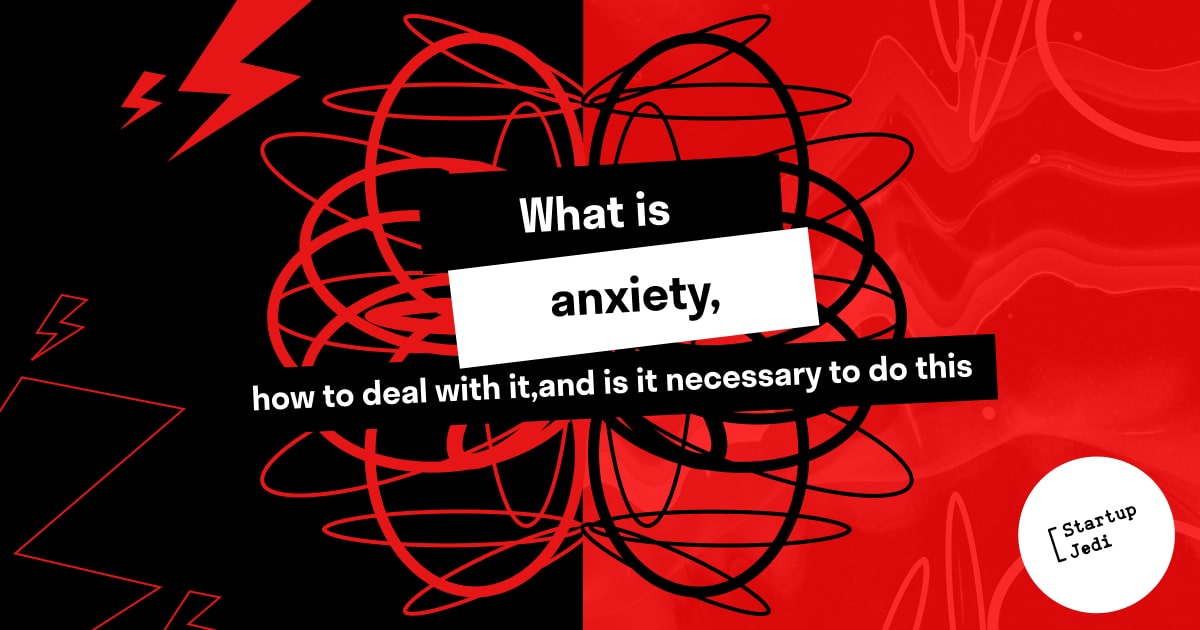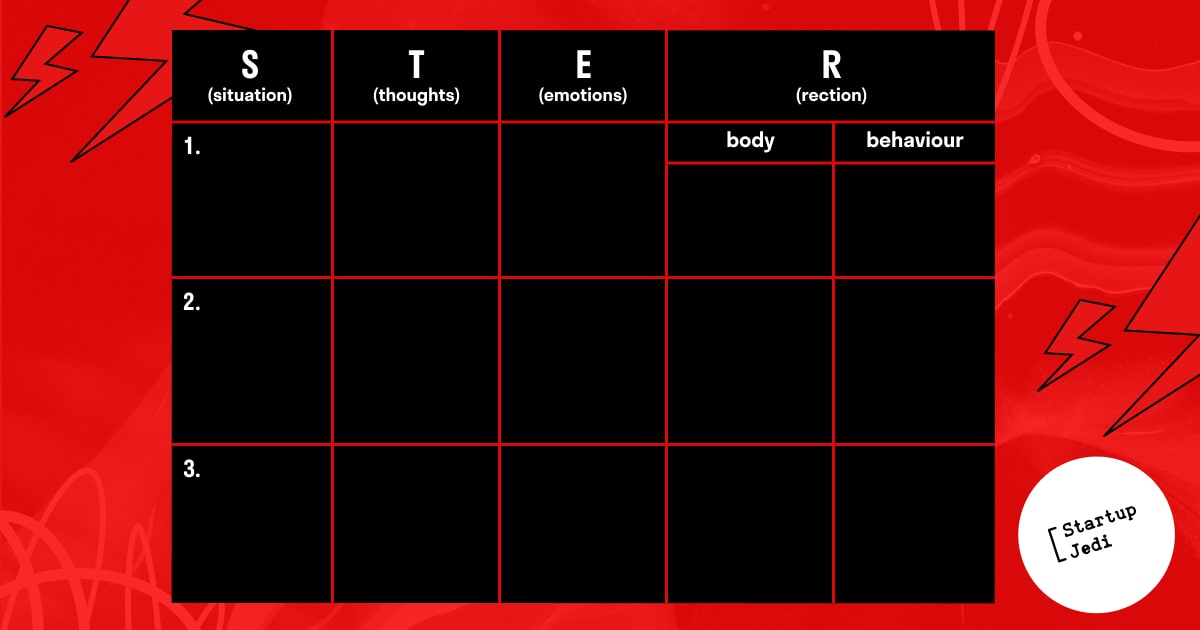
Startup Jedi
We talk to startups and investors, you get the value.
A colleague raised $500,000 for a startup, and you still live with your parents. “Am I not good enough?” — a thought that arises in your head. This is anxiety. We will help you figure out how to recognize and manage it for your benefit and your projects.

Startup Jedi
We talk to startups and investors, you get the value.
We are starting the publication of the articles on insights received from the private discussion groups of startup studio Founders Club.To choose an idea and upgrade it to a full-fledged startup, among other things you need to realize the changes in human nature that occur and will occur within the framework of the modern world structure.
Undoubtedly,personal and generational problems affect both the building of your business and the products/services developed by startups. We will try to consider the long-standing problems of generation Z, taking into account their psychological, behavioral and world-view characteristics, understand them from the point of view of previous generations, and show the possibilities of turning problems into triggers for development.
Since it is the Zetas that will soon become the main consumers of products and services, we will describe the new generation’s world view in order to understand what products will be in demand and how they will approach the building of their own businesses.

Anxiety ― this is a negatively colored emotion that helps you to get together and experience what you are afraid of. Unlike fear, anxiety is formed subconsciously, often the threat may be hidden.
It is normal to have anxiety, if it doesn't become a disorder. If we weren't worried, we wouldn't notice problems and growth zones. If we didn’t worry, we wouldn’t notice the problems and the growth zone. So you don’t have to be afraid of it. Think of anxiety as a normal body response to change and learn to manage emotions.
Freud believed that anxiety is the “innate property of a person, originally inherent to a person’s condition”. Cognitive psychology agrees with him, and says that anxiety helps in stress to focus on significant things and find answers. Worrying about meeting partners or interviewing is normal. So you’ll be better prepared and not distracted by the series.
In the midst of persistent anxiety, a disorder can occur, and it is a disease that requires treatment. In the United States, anxiety disorders are considered the most common diseases. They affect nearly 40 million people a year, and only 36,9% of people are treated. Prolonged anxiety disorder can lead to emotional burnout and even depression.

Here are the most common triggers that make us feel anxious:
Career and business
The job is disturbing almost everyone because that is what every acquaintance, relative, friend and forgotten classmate will ask you. You have to have a cool office, a paycheck with growing bonuses, business trips and a macbook. In order not to lose status, it is necessary to stay awake at night, to be connected 24/7 and parallel to take a course in a new profession. How to do everything in time?
Here are the symptoms to worry about:
sleep problems;
permanent feeling of fatigue;
trembling, nervous tic;
frequent sick days and days off;
inattention when performing tasks;
breaking deadlines;
increased emotionality in reaction to comments and changes.
Relationships with relatives
We don’t spend time with people we care about, we don’t talk to them, we don’t talk to them about our problems, misunderstanding grows like a snowball. At this moment everyone starts to complain that “no worthy partners” or “no one wants to move in”.
This is on condition that many are looking for a couple in rating applications and according to the Guardian, they underestimate self-esteem, increase the feeling of loneliness and even cause addiction on a par with gambling.
Social network
They teach us how to be successful and build into a cult “work on yourself”. Instagram is a hotbed of anxiety. In 2017, the BBC wrote about a social media study conducted by the Royal Society of Health. The article published a list of the most dangerous applications for mental health, in which Instagram and Snapchat were at the end of the mental health positive rating. It’s all about visual content. Sitting in an app where everything is perfect makes you feel inferior.
Another magazine, Computers and Human Behavior, determined that the trouble is not only in Instagram, but in a large number of social networks. According to the results of the interview, people with 7 or more accounts are 3 times more prone to anxiety. The norm is no more than two. So now think about what to delete first — Twitter or Tik Tok.
The situation in the world
Yes, we almost don't watch TV and try to have less contact with politics. But with the Internet and the fashion for an active civic position, it is almost impossible to stay out of the loop.
2020 gave us lots quests. The first was the coronavirus. There were already quite a few alarming ones, but there were even more — the pandemic doubled their number. Then there were elections and mass relocates on the list (if you are Belarusian). No matter how hard you try to protect yourself from the situation in the world, social networks "gladly" remind you of the news.

The alarm can be accompanied point―by-point — as problems arrive. If you recognize it in time, it will be even more useful. But prolonged anxiety is already a disorder that is included in the ICD classifier (International Classifier of Diseases). The reference book called it “Generalized anxiety disorder”.
According to some estimates, there are more than 100 potential symptoms of the disorder. So it will not be possible to determine an anxiety disorder by a test on the Internet. But you can try ― for example, use this test or this one. And we will list the bright markers that are worth thinking about.
You are worried, although the reason is insignificant — regularly and for at least six months.
You get annoyed for no reason. 90% of respondents with an anxiety disorder feel extremely hot-tempered even during an exacerbation — because their nervous system becomes hypersensitive.
Trouble sleeping, not just sometimes, but every night. Scientific studies confirm the link between insomnia and anxiety.
You're trying to do it perfectly, but you don't like the result. Making mistakes and thinking about how to avoid them in the future is normal. Self-flagellation and constant analysis are not so.
You feel constant tension in your muscles. It's a reaction to stress. The body seems to be preparing for action - to run, to defend itself.

Most likely, at this point you finally became sad and decided that anxiety would bring you to the grave. But not everything is so bad. Overcoming an anxious state is a victory for yourself.
Seren Kierkegaard called anxiety “the best teacher”. He believed that thanks to it we become stronger and more emotionally stable. It is an evolutionary tool to survive.
For example, a lot of people after self-isolation were worried about going to the office. Is it temporary fear? Or will the office be bad forever? A reflection on such an issue may reveal the root cause of the experience. Maybe going back to the office is scary, not because of a pandemic, but because of an abnormal manager. So maybe the solution is different?
Another example is the relocations in Belarus, which began in 2020. The political situation has forced many IT companies and startups to look in the direction of moving. There were much more opportunities for investment abroad before, but we tend to postpone changes for later. Many people have discovered new countries, launched startups. And it immediately seemed that the move would bring only suffering.

Evaluate the problem using the STER method
Draw the leaf into 4 columns (each with a letter, and divide “R” into two more blocks). In “S” (situation), write down what event disturbs you, in “E” (emotions) ― emotions and feelings that you experience. For example, fear and anxiety. Let's divide “R” (reaction) into “emotions” and “behavior” and describe what you felt in the body and what we wanted to do under the influence of emotions. For example, “reduced cheekbones” into bodily sensations and “wanted to escape” into behavioral ones.
“T” (thoughts) is filled in last. Here we write what we were worried about. For example, “I was afraid that…”
.

Write everything down distantly ― the first thing that came to mind. It's like it's an observation log. Then read everything you wrote down and evaluate what happened. For example: “I'm going to fall”. Is there any proof that this will happen? Imagine what the consequences will be. In this example the explanation may be: yes, you will fall, but there will be at least one passer-by on the street to help you up.
Load the body
Just one training session removes the focus on the problem at the moment, and regular sessions gradually remove anxiety symptoms.
Turn off the notifications and let yourself rest
Frequent use of gadgets makes you constantly be in suspense. Leave only the most significant chats enabled, and check the rest periodically. The same applies to the intensity of the working day — determine short breaks and distract yourself from the thought that “you don't have time for anything”.
Get creative
Hobby unloads from bad thoughts and allows you to switch attention to a task that has no deadlines, quality requirements and evaluation by others.
Adjust your breathing
The shallower we breathe, the greater the anxiety is. Deep breathing practices calm the nervous system and allow you to concentrate on the main thing. Try to do this ― inhale for 4 counts, hold your breath on the 8th, exhale on the 16th count. Or breathe deeply for 2 minutes: inhale and exhale for 4 counts.
You should not be afraid of anxiety if you have learned to balance it and not bring it to a state of disorder. The main thing is to be able to determine its appearance in time and use it for your development.
***
Are you also concerned about this topic, or maybe after reading this article, you wanted to express your opinion and offer a comprehensive solution to the problem?
Register in the Founders Club bot and join our community!
Facebook: facebook.com/StartupJedi/
Telegram: t.me/Startup_Jedi
Twitter: twitter.com/startup_jedi
Comments